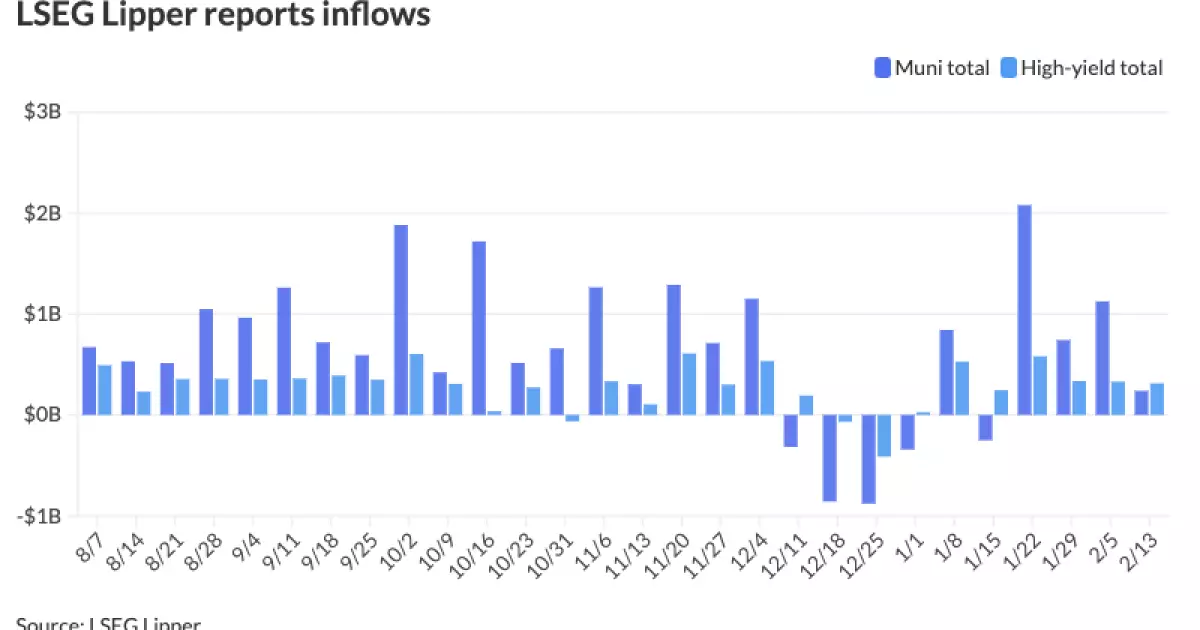The municipal bond market has been experiencing notable shifts driven by macroeconomic conditions, legislative developments, and evolving investor preferences. This article will explore several key dynamics influencing the muni landscape in light of current fiscal realities and investor behaviors.
As of late January 2023, municipal bonds demonstrated a strengthened position, largely due to favorable shifts in U.S. Treasury yields and an uptick in equity performance. According to recent data from Municipal Market Data (MMD) and ICE Data Services, the ratios comparing municipal bond yields to U.S. Treasury yields are solidly aligned, particularly in the longer durations. For example, the 30-year municipal bond ratio reached 86%, reflecting a shrinking spread that attracts investors seeking relative value.
Prominent experts, such as James Welch from Principal Asset Management, emphasize that the trajectory of the muni market is significantly influenced by developments in Washington. Uncertainty surrounding the political landscape, especially concerning President Trump’s tax policies and potential alterations to monetary policy, poses both risks and opportunities for investors. Welch notes that despite external pressures—like trade tariffs and budgeting challenges—the muni market has exhibited resilience and steady fund flows.
Recent trends in fund flows suggest that despite some underperformance relative to other asset classes, municipal mutual funds have demonstrated robust inflows. As reported by LSEG Lipper, municipal bond mutual funds saw an influx of approximately $238.5 million recently, following a larger influx of over $1 billion in the previous weeks. High-yield municipal funds, in particular, maintained strong appeal, attracting $313 million during the same period.
This consistent demand from investors indicates a favorable outlook for the muni market, with Welch suggesting that retail participation—including through funds and exchange-traded funds (ETFs)—will remain a critical component of the market’s dynamics. He attributes this sustained interest to dwindling federal investment following the previous administration’s policies, necessitating greater reliance on municipal bond issuance for financing projects.
Issuance levels in the muni market have remained robust, totaling $50.74 billion year-to-date and showcasing a 12.5% year-over-year increase. Many municipalities are confronting longstanding issues of deferred maintenance: the failure to address essential infrastructure projects that were put on hold during the pandemic. Welch indicates that this pending need will compel more municipalities to re-enter the market for financing solutions, potentially expanding the scope of investment opportunities for disciplined investors.
The scenario is further bolstered by the unique characteristics of the current yield curve, which has seen term extensions beyond the 10-year marks attracting liquidity from cash products. Portfolio managers like Kim Olsan of NewSquare Capital emphasize the changing investor behavior as yields for longer-term bonds surpass those available in money market funds, leading to repositioning in portfolios away from ultra-short-term holdings.
The increased volume of trading activity in the municipal bond space reflects a heightened engagement from diverse market participants. The average daily notional volume traded has rounded up to an impressive $13.1 billion, closely paralleling 2024 figures and showcasing an upward trajectory following a drop in 2022. This active trading environment is spurred by both soaring issuance levels and significant net fund inflows, highlighting a vibrant backdrop in which municipal bonds are actively sought after.
Innovations in trading technology, particularly the rise of electronic trading platforms and Separately Managed Accounts (SMAs), have also transformed the landscape. Kevin McPartland from Coalition Greenwich notes that the growing adoption of e-trading, which represented around 18.4% of notional volume in 2024, facilitates quicker and more efficient trading processes.
Moreover, the ability of SMAs to provide automated account management—helping investors realign their portfolios with a level of autonomy—has made this segment particularly attractive among high-net-worth individuals seeking complex and efficient investment solutions.
As the municipal bond market continues to adapt to evolving economic and regulatory environments, several factors will dictate its future trajectory. Investors should remain vigilant about macroeconomic developments, legislative changes, and technological advancements. By grasping these dynamics, market participants can position themselves to optimize their investment strategies in what promises to be a fluid and evolving landscape. The resilience shown by municipal bonds amid fiscal challenges speaks to their enduring appeal as a cornerstone of many investment portfolios.

